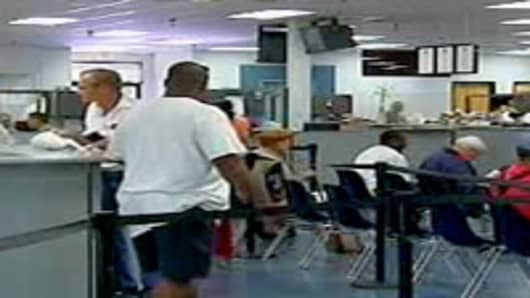Job creation in 2010 has been slow but unsure, coming in a weak trickle that has left investors unsatisfied and asking what it will take to actually get employment moving in a meaningful way.
Thursday's weekly jobless claims reportonly reinforced what Wall Street already knew—that despite halting signs of improvement, 479,000 new filings for unemployment insurance was hardly indicative of a robust recovery.
As such, the stock market sold offand strategists and analysts were left to ponder how long it will take for things to turn accelerate off the weak growth that has taken place this year.
"The question is when is that going to pick up enough to meaningfully lower the unemployment rate and spark the virtuous cycle of upward momentum, to get employment, wages and aggregate demand higher," says Tom Higgins, chief economist at Payden & Rygel in Los Angeles. "That takes time. If you look back at the last two cycles, employment recoveries have been slow."
Economists and employment experts say four things will have to happen to get jobs moving:
1. Positive Momentum
Slowdowns are as much psychological phenomena as they are economic, with confidence the key as much as any other factor.
With the news mostly bad about the economy, companies are afraid to hire until a more positive tone comes about.
"Hiring has tended to be slow the last two cycles," Higgins says. "The trajectory coming out of this recession is even shallower. That likely means the trajectory of hiring is much shallower."
One of the main problems is an economic Catch-22: Companies won't hire until they see more strength from consumers, and consumer spending can't get stronger if people don't have jobs. That means corporate America will have to rely on "small positives" to keep building until confidence is established, says Kurt Karl, chief US economist at Swiss Re in New York.
"Businesses like to look at year-over-year growth in sales, and that just isn't that strong yet. But it should be better and better as get deeper into the recovery," Karl says. "With these unemployment recoveries, you either get one extreme or the other. You're either booming, or it's crash and burn. But we're muddling in between."
2. Loans to Small Business
While the biggest companies sit on the lion's share of the $1.8 trillion in cash on corporate balance sheets, small businesses are groping for funds.
That's not been made any easier by banks that have been loathe to lend as they meet capital requirements laid out in the new financial reform legislation. Without that access to capital, small businesses will be unlikely to add new employees.
"We need small businesses, which generate 60 percent of the jobs, to get more access to lending, to capital, so people can take risks," says John Challenger, CEO at job outplacement firm Challenger, Gary & Christmas. "Entrepreneurs rely on savings, but those savings have been depleted."
The ability to invest in companies and develop products will help spur the demand needed to create jobs, Challenger says.
Small businesses in the recessionary environment "don't have access to the savings they might normally have. On the front end, with small businesses not there to pick up the slack, that's a very important hindrance to getting this economic engine going," he says.
3. Foreign Demand
American consumers—even those with jobs and savings—are focused on paying down debt and not greasing the economic skids.
As such, the jobs market may have to rely on low export prices and consumers in robust developing economies to help generate demand.
"One thing we do know is exports are strong. Overseas economies are doing quite well," says Brian Gendreau, market strategist with Financial Network Investment, based in El Segundo, Calif. "For large-cap stocks, more and more revenues are going to come from abroad. That's where we're going to get the growth."
Of 250 companies in the Standard & Poor's 500, 46.6 percent of all sales came outside the US in 2009, actually a slight decrease from the previous year, according to S&P.
But Gendreau sees capital expenditures increasing in a way that seems to anticipate more spending coming soon.
"Companies seem to be spending a lot of money in anticipation of demand that doesn't look obvious it will show up," he says.
4. Capital Spending
Indeed, one of the main precursors seen for employment growth is capital spending by companies on plants and equipment.
In fact, Deutsche Bank analysts say cap-ex spending this year is robust—growing 20 percent over the previous quarter—and the trend traditionally leads the jobs market by a full quarter. The movement in cap-ex, says Deutsche economist Joseph A. LaVorgna, suggest a strong jobs-creation move in the third quarter.
"Taken literally (the comparison between cap-ex and jobs) implies we will see several million jobs created over the next few quarters," LaVorgna said in a note to clients. "While we are not so bold to forecast such sizeable job gains, we wonder whether there is some upside risk to our slightly above consensus forecast for July private payrolls."
Deutsche is projecting Friday's nonfarm payrollsto show job gains of 110,000 in July, compared to the consensus of 90,000.
That would be some indication that Wall Street is putting cash to work.
"We all know companies are sitting on mounds and mounds of cash, possibly record amounts of cash," Gendreau says. "The question is, when are they going to start putting it to work?"



